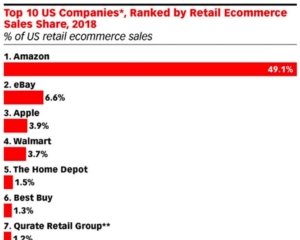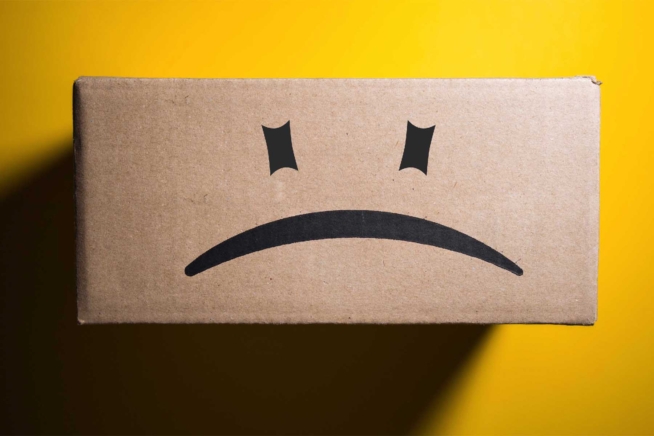 eMarketer reported that, in 2018, Amazon owned nearly 50% of America’s eCommerce market and that is 5% of all online retail expenditures.
eMarketer reported that, in 2018, Amazon owned nearly 50% of America’s eCommerce market and that is 5% of all online retail expenditures.
At least 25% of the $1.8B in global counterfeiting losses—which amounts to $450,000,000—come from eCommerce, according to the Global Brand Counterfeiting Report, and it’s rampant on Amazon.
It’s important to understand that, while Amazon certainly tries to fight counterfeit sales, their platform struggles to stem the tide of counterfeit merchandise.
In February 2019, Amazon announced a new initiative to help “drive counterfeits to zero” on its platform, but will this be enough to slow the growing tide of fake sellers?
Is it possible for companies to stop counterfeit sales of their merchandise on Amazon completely?
Yes.
Speak to an Anti-Counterfeiting Expert Today
How counterfeits end up for sale on Amazon

-
Merchandise is stolen and listed for sale on Amazon.
Product diversion is a supply chain issue where merchandise is stolen during transit and sold on Amazon, often at a discount compared to suggested retail prices.
-
Discounted products are purchased legally by an employee of the company and sold on Amazon.
Large brands often reward employees by offering discounted products. Unfortunately, some unethical employees take advantage of this benefit by re-selling merchandise for a suggested retail price and make a profit from the sales.
-
Merchandise is purchased legally in the US or another approved country, then sold in another non-approved country where the company does not operate.
Often, these counterfeits are sold above the standard retail price in a foreign country. In these cases, the price is not an issue. The issue here is product availability. Consumers will pay a premium for products that are not as accessible in their country.
At the end of the day, all three of these counterfeiting scenarios combined can cost brand owners trillions in lost revenues each year.
When it comes to combating counterfeit merchandise being sold on Amazon, many big brands are still playing defense.
For those brands whose products are serialized using Covectra’s track and trace technology, the game is an offensive one that protects the brand’s integrity and bottom line.

Counterfeits on Amazon harm the big brands.
There is a massive opportunity for sellers of all kinds to increase their revenues using Amazon.com, no matter what the size of the company.
Fulfillment by Amazon (FBA) has made the barrier to selling on Amazon almost non-existent. Alongside companies like Apple, this means that an individual seller can begin selling merchandise on Amazon also.
Amazon FBA allows sellers to send in merchandise to be stored in Amazon’s warehouse and shipped free through Amazon’s Prime membership. This is part of the reason why fakes are easy for illegitimate merchants to sell.
More than 300,000 US-based small businesses began selling on Amazon in 2019 alone.
Unfortunately, many of those merchants are illegitimate sellers who copy and sell patented products on Amazon easily.
Companies, often in China or the Middle East, replicate an item—often using the item’s trademarked logo, and then selling the item at a significantly lower price point.
For the legitimate companies trusting Amazon’s marketplace, counterfeits harm their bottom-line. Lost revenue, damage to the brand’s reputation, IP theft, and hours of time spent disputing, are the result.
Counterfeits are a huge threat to the integrity of brands and ultimately cost legitimate brands valuable resources, like time spent counteracting the fraud and money spent on legal fees.
In the end, counterfeits on Amazon are a huge headache and an uphill battle for big brands.
Speak to an Anti-Counterfeiting Expert Today
Counterfeit merchandise can hurt consumers, too.

Trusted brands have manufacturing standards, but pirating counterfeiting manufacturers may have poor manufacturing standards that can result in faulty batteries or poorly designed transformers that are actually explosive under certain conditions, for example.
Counterfeit product quality standards are not regulated and therefore a fake piece of merchandise can operate differently than promised.
One example of a low-quality counterfeit product hurting the consumer comes from Alana Semuels, staff writer for the Atlantic.
In her story, Amazon May Have a Counterfeit Problem, Semuels writes:
“When I ordered a pair to see how similar they were to the real thing I got, through Amazon Prime, a pair of headphones that look exactly like AirPods, except that they didn’t work very well and their instruction manual was written in nonsensical English.
When making calls, there is only one side earphone working, and there’s an incoming call, it would broadcast calling numbers.”

Brand protection is a business.
Covectra’s Track & Trace technology offers the highest level of brand protection available today.
Here’s why:
- Brand owners can know where their products are in the supply chain.
- Points of counterfeiting or diversion can be determined very quickly, thus providing an opportunity for rapid intervention.
- Help end-users build confidence knowing they have purchased a genuine product.
- Consumer mobile applications can be created to establish a direct link between the manufacturer and the end-users.
How to stop Amazon counterfeiters.

By doing this, counterfeit product sales under your brand name can easily be identified and you can take action to have fakes removed from Amazon’s platform.
Covectra’s AuthentiTrack® provides this brand protection and even supply chain integrity through unit-level serialization and aggregation for unparalleled product tracking.

